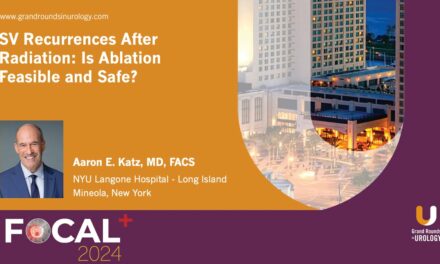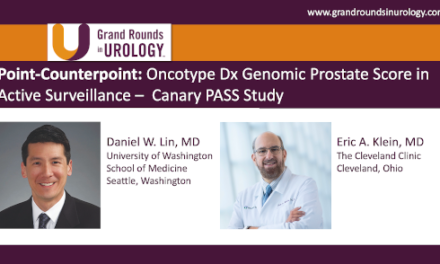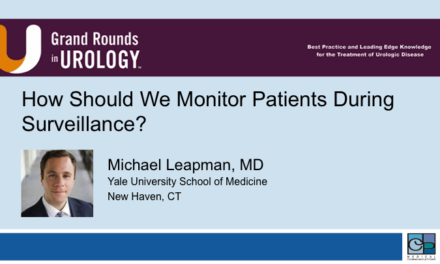
PCa Commentary | Volume 161 – January 2022
Posted by Edward Weber | January 2022
BIPOLAR ANDROGEN THERAPY (BAT): A Treatment Option for Metastatic Castration-Resistant Prostate Cancer (mCRPC).
The BAT regimen was introduced in January 2015 in a report by Schweizer and his Johns Hopkins colleagues: “Effect of Bipolar Androgen Therapy for Asymptomatic Men with Castration-Resistant Prostate Cancer” (Sci Transl Med). In their study, 16 men with low to moderate metastatic burden received monthly cyclic intramuscular testosterone (T) injections, which elevated the ADT-suppressed T from castrate to supraphysiologic levels greater than 1500 ng/dl. The T levels fell back to baseline by 28 days. During treatment, androgen suppression was maintained.
Results: A 50% drop in PSA (PSA50) as well as a radiographic response were seen in half the patients. Of special importance (and a continuing theme in future research and in this Commentary): “All patients (10 of 10) demonstrated PSA reductions upon receiving [subsequent] androgen-ablative therapies [i.e., Xtandi or Zytiga], suggesting that BAT may also restore sensitivity to ADT.”
Proposed mechanism for BAT suppression of prostate cancer growth:
This issue was extensively investigated by Chatterjee, Schweizer, Nelson and colleagues (J Clin Investig, Sept 2019), with their conclusion that supraphysiologic androgen (SPA) suppresses cancer growth by inducing DNA damage. They noted that androgen receptor signaling was markedly increased as an adaptive response to castrate levels of testosterone. In response to castrate T levels, the androgen receptor increases copy numbers by 30 – 90-fold and accumulates resistance mutations such AR-V7, against which BAT has been found effective.
The study found that SPA:
1. Induces double stranded DNA breaks and simultaneously suppresses DNA repair
2. Arrests the cycle of cellular proliferation
3. Promotes a 45% increase in cell death (apoptosis)
This lethal result was especially prominent in the presence of deleterious mutations in the BRCA family of DNA repair genes. This observation suggested that “…these findings support clinical trials of SPA in combination with PARP inhibitors” such as olaparib and rucaparib (the combination BAT/olaparib is already under protocol study).
Two examples of BAT restoring sensitivity to hormone therapy after resistance develops to a prior androgen receptor targeted agent such as Zytiga.
Example 1: (J Clin Oncol. Feb 2021)
The ‘TRANSFORMER’ trial compared responses (evaluated by CT and bone scans) in men who had progressed on prior abiraterone (Zytiga). The BAT regimen was administered to 94 men while 101 received standard enzalutamide (Xtandi) along with ADT. The radiographic progression-free survival for both BAT and enzalutamide (ENZ) was 5.7 months.
Of significance, however: When progression was noted in each arm, a crossover to the alternate arm was allowed. A PSA50 was seen in 77.8% of patients crossing to BAT from ENZ, compared to 23.3% in crossing from ENZ to BAT, confirming the hypothesis that BAT sensitizes cancer to subsequent ENZ therapy. The overall survival in the BAT to ENZ schema was 32.9 months vs. 30.2 months for the reverse.
Their key observation: “However, the most important finding is that post-abiraterone BAT can markedly improve the magnitude and duration of response to enzalutamide when used as an intervening [i.e., subsequent] therapy.”
Example 2: (Sena et al. Eur J Cancer. 2021)
The ‘RESTORE’ trial of 29 patients found a modest 14% PSA50 response to BAT when used after progression on ADT. But when Zytiga or Xtandi were used following BAT, the responses were impressive: 85% of men showed PSA90 response (15 of 18). “Twelve of 15 patients … with metastatic CRPC remain on abiraterone or enzalutamide with a median duration of follow-up of 11.2 months.”
Their key observation: The adaptive upregulation of the androgen receptor responding to castrate T levels “generates a therapeutic vulnerability to high-dose T treatment.”
Adverse effects AND beneficial effects of BAT:
Adverse effects: In the TRANSFORMER trial, the adverse effects of BAT were compared to those of enzalutamide.
Findings – BAT vs. enzalutamide: Fatigue, 31% vs. 48%; generalized pain, 31% vs. 16%; limb edema, 17% vs. 11%; back pain, 20% vs. 24%; diarrhea, 11% vs. 24%; nausea, 13% vs. 22%; appetite loss, 12% vs. 28%; depression, 1% vs. 13%; anxiety, 2% vs. 9%; hot flashes, 8% vs. 10%; and hemoglobin gain, 3.4% vs. 0%.
Beneficial effects: Changes in physical parameters seen after three months of BAT in men with mCRPC were reported by Marshall et al. (BJUI, March 2021). “The 60 included patients had a mean decrease of 8.2% of subcutaneous fat and 18.2% of visceral fat and gained 6.7% in muscle mass.” Substantial improvement was seen in lipid levels: LDL, HDL and triglycerides were all down 12.4%, 9.1%, and 26.9% respectively, and quality of life was generally improved.
Their conclusion: “This is the only therapy to date for the treatment of advanced prostate cancer that is associated with these improvements and has promising implications for the long-term health of men with mCRPC.”
BOTTOM LINE:
BAT has been found equivalent in radiographic-free survival to enzalutamide when used after progression on ADT in mCRPC, but significantly improves the response and duration of a follow-up second generation AR targeted therapy following BAT. This suggests a place for BAT early in the sequence of therapy of men with mCRPC, a regimen which has to be further validated.
Your comments and requests for information on a specific topic are welcome e-mail ecweber@nwlink.com.
Please also visit https://prostatecancerfree.org/prostate-cancer-news for a selection of past issues of the PCa Commentary covering a variety of topics.
“I want to thank Dawn Scott, Staffperson, Tumor Institute Radiation Oncology Group, and Mike Scully, Librarian, Swedish Medical Center for their unfailing, timely, and resourceful support of the Commentary project. Without their help this Commentary would not be possible.”
ABOUT THE AUTHOR
Edward Weber, MD, is a retired medical oncologist living in Seattle, Washington. He was born and raised in a suburb of Reading, Pennsylvania. After graduating from Princeton University in 1956 with a BA in History, Dr. Weber attended medical school at the University of Pennsylvania. His internship training took place at the University of Vermont in Burlington.
A tour of service as a Naval Flight Surgeon positioned him on Whidbey Island, Washington, and this introduction to the Pacific Northwest ultimately proved irresistible. Following naval service, he received postgraduate training in internal medicine in Philadelphia at the Pennsylvania Hospital and then pursued a fellowship in hematology and oncology at the University of Washington.
His career in medical oncology was at the Tumor Institute of the Swedish Hospital in Seattle where his practice focused largely on the treatment of patients experiencing lung, breast, colon, and genitourinary cancer and malignant lymphoma.
Toward the end of his career, he developed a particular concentration on the treatment of prostate cancer. Since retirement in 2002, he has authored the PCa Commentary, published by the Prostate Cancer Treatment Research Foundation, an analysis of new developments in the prostate cancer field with essays discussing and evaluating treatment management options in this disease. He is a regular speaker at various prostate cancer support groups around Seattle.




